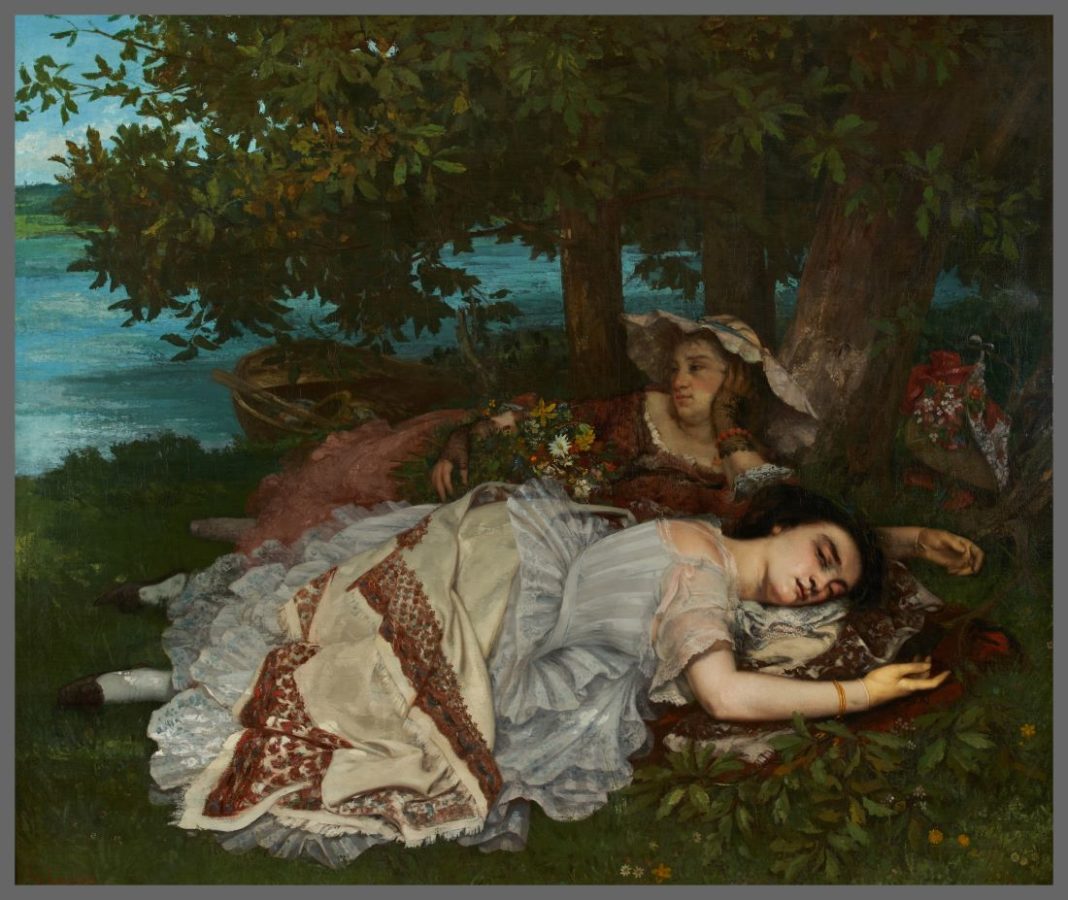Quando si dice Courbet, viene in mente la sua scandalosa origine del mondo. A quel piccolo dipinto conservato al Museo d’Orsay di Parigi che, quando fu realizzato, nel 1866, rappresentò un fendente di libertà alla mentalità borghese e benpensante. L’erotismo non era annunciato ma svelato con efficaci spatolate raffiguranti la vulva femminile in quanto principio della vita.
Gustave, questo il suo nome di battesimo, fu realista a oltranza, insofferente a qualsiasi pressione, deciso a essere un uomo libero fino all’ultimo respiro. Rappresentando ciò che si spalancava davanti a i suoi occhi. Semplici momenti del quotidiano che prendevano a calci la rigidità accademica, come Les demoiselles des bords de la Seine (foto).
E queste due fanciulle, ritratte sulla riva del fiume parigino, provenienti dal Petit Paleis della capitale francese, adesso possono essere ammirate, da oggi, giovedì 7 novembre fino al 23 febbraio 2025, nella sala 6 della bellissima pinacoteca di Capodimonte.
E’ il 1857 quando il pittore presenta il quadro al Salon, nello stesso anno in cui Flaubert dà alle stampe in due volumi il celebre romanzo “Madame Bovary” (subito messo sotto accusa per immoralità e oscenità) e Baudelaire pubblica i Fiori del male, la raccolta di poesie (messa sotto sequestro) che valse a autore e editore una condanna per oltraggio alla pubblica morale e al buon costume.
L’atteggiamento della società di quel tempo è incline, dunque, alla durezza della censura, ma le signorine di Courbet conquistano pubblico e mecenati e ne consacrano il successo.
Ma perché queste demoiselles sono così trasgressive come lo era il loro papà artistico? E’ una giornata estiva, fa caldo, le due giovani donne ispirano malizia e sensualità, che non appartengono ragazze di buona famiglia, ma a dispensatrici di amore a pagamento. Una delle due indossa guanti di pizzo nero, l’altra è languidamente adagiata sull’erba e ha gli occhi chiusi. La loro pelle è ombrata di sudore, vicinissima e palpabile: sembrano pronte a uscire dalla cornice.
La grande tela inaugura un nuovo ciclo del museo di Capodimonte che ha appena ritrovato i suoi capolavori prestati al Louvre per la suggestiva mostra su Napoli. Courbet, infatti, dà avvio al dialogo con opere che hanno segnato la storia dell’arte: «Un prestito di grande significato cukturale – afferma il direttore Eike Schmidt- anche per la città: sono tanti gli artisti napoletani dell’Ottocento che nel loro lavoro mostrano il fascino esercitato dalla personalità di Courbet».
Intanto, domani venerdì 8 novembre, partono le visite guidate gratuite sul tema Bellezza a Corte per adulti, insieme a percorsi didattici per bambini e le loro famiglie proposte dal Museo di Capodimonte in occasione dell’apertura della sala 62 dei Capolavori che ospita, in un allestimento ad hoc, diciotto opere iconiche delle collezioni storiche – da Tiziano a Caravaggio, da Parmigianino a Warhol – rientrate da lunghi prestiti.
Necessaria la prenotazione da inviare all’indirizzo mail mucap.accoglienza.capodimonte@cultura.gov.it (attendere il messaggio di conferma con le indicazioni per l’appuntamento).
Per saperne di più
https://capodimonte.cultura.gov.it/
Museo di Capodimonte/ Gustave Courbet, French guest between 2 maidens on the banks of the Seine. The dialogue with international museums begins
Mention Courbet and the scandalous origin of the world comes to mind. This small painting in the Musée d’Orsay in Paris was, at the time of its creation in 1866, a blow of freedom against the bourgeois mentality. Eroticism was not announced, but revealed in the effective brushstrokes that depicted the female vulva as the principle of life.
Gustave, that was his first name, lived as a realist, intolerant of any pressure, determined to be a free man until his last breath. He depicted what was happening in front of his eyes. Simple moments of everyday life that threw academic rigidity out of the window, such as the Demoiselles des bords de la Seine.
And these two maidens, portrayed on the banks of the Paris river, from the Petit Palais in the French capital, can now be admired from today, Thursday 7 November, until 23 February 2025, in the hall 6 of the beautiful Capodimonte picture gallery.
It was 1857 when the painter exhibited the painting at the Salon, the same year that Flaubert published his famous two-volume novel Madame Bovary (immediately condemned for immorality and obscenity) and Baudelaire published Flowers of evil, a collection of poems (confiscated) that earned the author and publisher a prison sentence for offending public morals and decency.
The attitude of society at the time was therefore one of strict censorship, but Courbet’s Demoiselles attracted the audience and patrons, and their success was consecrated.
But why are these demoiselles so transgressive, as their artist father was? It is a summer’s day, it is hot, the two young women inspire a wickedness and a sensuality that do not belong to girls from good families, but to the dispensers of love for money. One of them wears black lace gloves, the other lies lazily on the grass with her eyes closed. Their skin is shaded with sweat, close and tangible: they seem ready to step out of the frame.
It was 1857 when the painter exhibited the painting at the Salon, the same year that Flaubert published his famous two-volume novel Madame Bovary (immediately condemned for immorality and obscenity) and Baudelaire published Flowers of evil, a collection of poems (confiscated) that earned the author and publisher a prison sentence for offending public morals and decency.
The attitude of society at the time was therefore one of strict censorship, but Courbet’s Demoiselles attracted the audience and patrons, and their success was consecrated.
But why are these Demoiselles as transgressive as their artistic father was? It is a summer’s day, it is hot, the two young women inspire a wickedness and a sensuality that do not belong to girls from good families, but to the dispensers of love for money. One of them wears black lace gloves, the other lies lazily on the grass with her eyes closed. Their skin is shaded with sweat, close and tangible: they seem ready to step out of the frame.
The large canvas inaugurates a new cycle at the Capodimonte Museum: “A loan of great cultural importance,” says director Eike Schmidt, “also for the city: there are so many 19th-century Neapolitan artists whose work reflects the fascination of Courbet’s personality.”
Meanwhile, tomorrow, Friday 8 November, the Capodimonte Museum is offering free guided tours on the theme of “Beauty at Court” for adults and educational itineraries for children and their families, on the occasion of the opening of Room 62 of the Masterpieces, where eighteen iconic works from the historic collections – from Titian to Caravaggio, from Parmigianino to Warhol – will be displayed in an ad hoc setting, returned from long absences.
Reservations are required and should be sent to mucap.accoglienza.capodimonte@cultura.gov.it (please wait for a confirmation message with appointment instructions).
Learn more at
https://capodimonte.cultura.gov.it/
.










